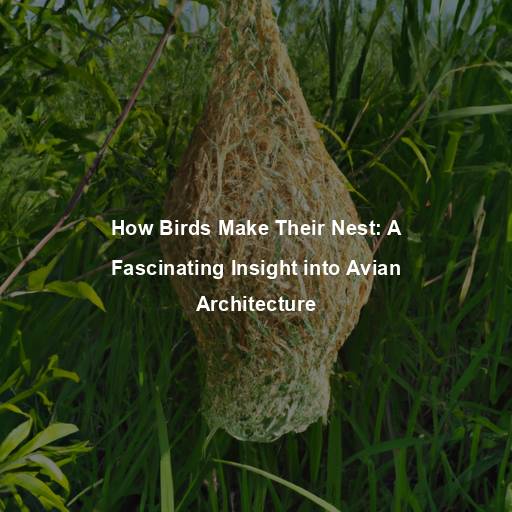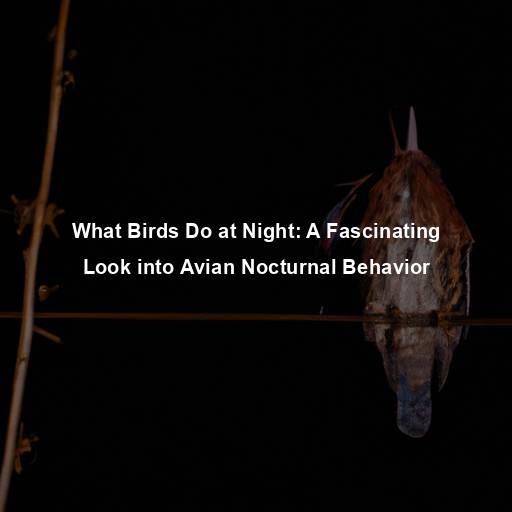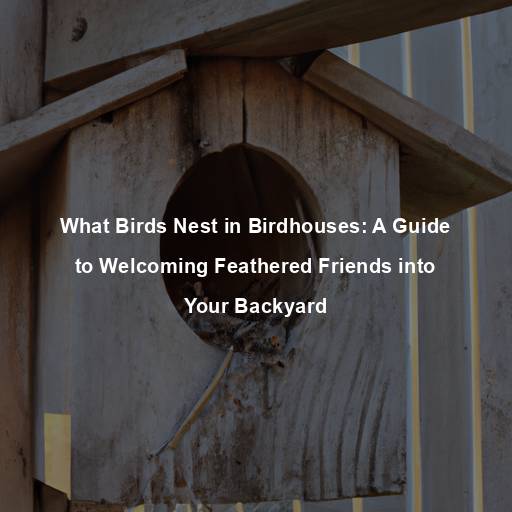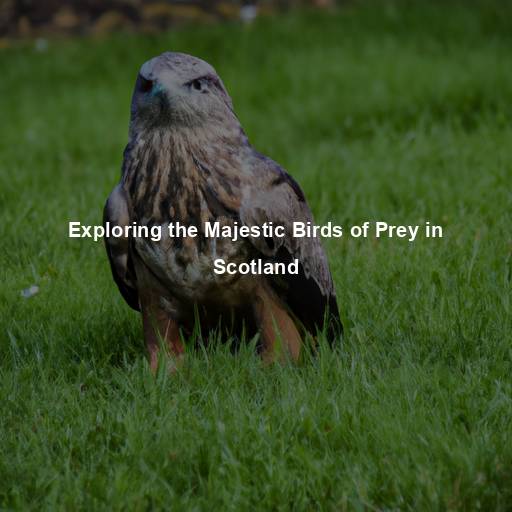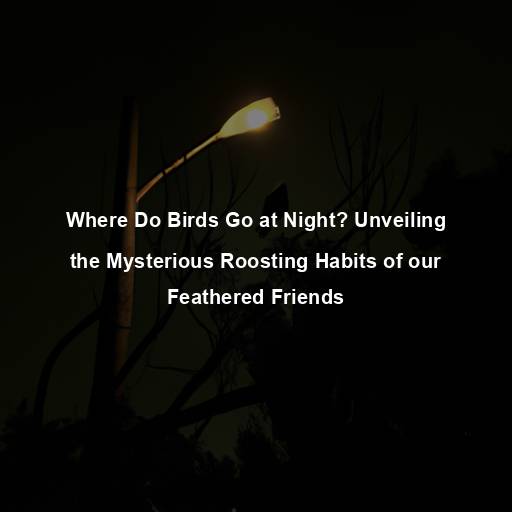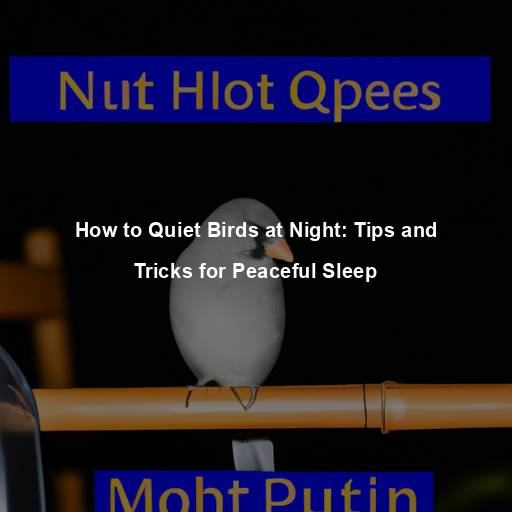How Birds Make Their Nest: A Fascinating Insight into Avian Architecture
Last Updated on October 22, 2023 by Evan
Contents
- 1 The Wonders of Nature
- 2 Understanding the Purpose
- 3 A Multitude of Architectural Styles
- 4 Materials and Techniques
- 5 The Role of Instinct and Learning
- 6 A Testament to Avian Intelligence
- 7 Nesting Challenges and Adaptations
- 8 Human Impact on Bird Nests
- 9 The Ever-Evolving World of Bird Nests
- 10 A Testament to Nature’s Beauty
- 11 FAQs – How Birds Make Their Nests
The Wonders of Nature
Nature never fails to amaze us with its extraordinary creations. From the majestic mountains to the serene oceans, every aspect of our natural world holds its own unique wonders. One such marvel that often goes unnoticed is the intricate and awe-inspiring nests built by birds. These avian architects exhibit remarkable skills and ingenuity in constructing their homes, each tailored to suit their specific needs.
Understanding the Purpose
When we ponder the fascinating world of nest construction, we are confronted with an enigmatic marvel that begs further exploration. What drives birds to meticulously craft these astonishing abodes? The answer lies in their innate quest for safeguarding their precious eggs and vulnerable hatchlings. Through artful construction, birds fashion a shield against the perils of the wild, shielding their offspring from both elusive predators and the whims of an unpredictable climate.
A Safe Haven for Future Generations
Birds invest significant time and effort in constructing their nests to ensure the survival of their species. Nests provide a safe haven where eggs can incubate and hatch, offering a controlled environment that ensures optimal conditions for embryonic development. Additionally, the structure of the nest helps to regulate temperature and humidity, ensuring the well-being of the growing chicks.
Courtship Displays and Territory Marking
Birds and their penchant for nest building is not only a fascinating spectacle, but it also serves multiple purposes in their avian world. One such purpose is courtship displays, where male birds showcase their architectural prowess to catch the attention of potential mates. These intricate constructions can be seen as a measure of the male’s fitness and genetic superiority, adding an intriguing layer to the process of mate selection. Additionally, the location and size of the nests also serve as a territorial marker, leaving other birds with no doubt that the area has already been claimed.
A Multitude of Architectural Styles
Bird nests come in a remarkable array of shapes, sizes, and materials, each tailored to suit the unique needs and lifestyles of different bird species. Let’s explore some of the most fascinating architectural styles found in the bird world.
Cup Nests: Simplicity at Its Finest
Nest building holds an enchanting place in nature’s grand symphony, with the cup nest gracefully stealing the spotlight. Picture a delicate cradle, its contours gently sculpted to mimic the embrace of a bowl. Weaving a tale of resourcefulness, these avian architects fashion their creations with an eclectic mix of twigs, grass, leaves, and botanical treasures. And should you dare to peer inside, a whimsical surprise awaits -a plush sanctuary of feathers, moss, or the unexpected touch of animal fur.
Cavity Nests: Utilizing Existing Spaces
When it comes to nest building, cavity-nesting birds have a unique strategy that sets them apart. Instead of starting from scratch, these clever avian creatures tap into existing resources, whether it’s a hollow tree, an abandoned burrow, or even a carefully designed birdhouse. With meticulous modifications, they transform these cavities into well-appointed sanctuaries for their precious eggs, ensuring both comfort and protection.
Platform Nests: Foundations in the Sky
Discover the mesmerizing world of avian architecture with the captivating creation known as the platform nest. A testament to nature’s ingenuity, these architectural wonders are delicately crafted by regal creatures such as the majestic eagles and the graceful ospreys. Marvel at the stunning resemblance to a floating platform or a graceful shallow bowl, expertly nestled amidst the branches of towering trees or perched precariously on rugged cliffs. Witness the craftsmanship as sturdy branches, twigs, and grass intertwine to create a secure haven where the next generation of feathered wonders will flourish in perfect harmony.
Pendant Nests: Hanging Wonders
When it comes to building homes, some winged wonders like orioles and weaverbirds truly know how to flaunt their dexterity. Picture this: delicate pendant nests gracefully hanging from tree branches, almost like nature’s art installation. These birds amaze us with their extraordinary talent for weaving intricate patterns using grass, plant fibers, and even spider silk. It’s mind-boggling to witness their architectural prowess in action.
Burrow Nests: Underground Sanctuaries
Burrow nests are a unique adaptation observed primarily in ground-nesting birds. These species, like puffins and kingfishers, excavate burrows in soil or use pre-existing tunnels to create subterranean nests. Burrow nests provide excellent protection and insulation, shielding the eggs and chicks from the harsh elements and predators.
Materials and Techniques
Birds employ a wide range of materials and techniques when constructing their nests, showcasing their resourcefulness and adaptability.
Natural Materials: A Symphony of Nature
In the wild, avian architects take on the extraordinary task of gathering an array of nature’s finest offerings to weave together a nest like no other. Their selection of twigs, leaves, grass, and moss is an intricate dance, a symphony of choices to create a home of ultimate strength, adaptability, and warmth. The brilliance of some birds, however, lies in their ingenious decision to incorporate the humble mud, a secret ingredient that fortifies their masterpiece, providing an unrivaled shield against the elements and ensuring a sanctuary unrivaled in stability.
Unconventional Building Blocks
It’s truly remarkable how versatile birds can be when it comes to building their nests. Not only do they rely on natural materials like feathers and animal fur, but they also have a knack for incorporating some rather unconventional items. Think discarded plastic and bits of string that you wouldn’t expect to find in a bird’s nest. Surprisingly, these unlikely materials play important roles in insulating the nests and dissuading potential predators, reminding us of the ingenuity found in nature’s design.
Skillful Weaving and Knotting
Step into the realm of feathered artisans, where weaverbirds reign supreme with their unparalleled weaving prowess. With delicate finesse, they transform humble strands of grass, leaves, and supple plant materials into architectural wonders. Each meticulous twist, knot, and interlace ensures a final creation that boasts unrivaled strength and unwavering durability. Behold the intricate masterpieces these avian craftsmen create, standing as testaments to their skill and ingenuity.
Adapting to the Environment
Birds demonstrate remarkable adaptability when it comes to nest construction. Species living in colder climates, such as the Arctic tern, build nests with thick insulation to protect against freezing temperatures. Conversely, birds residing in warmer regions, like the baya weaver, construct nests with strategic ventilation to combat excessive heat. These adaptations highlight the adaptive nature of avian architecture.
The Role of Instinct and Learning
When it comes to nest building, birds are full of surprises. They seem to innately know how to construct intricate homes without any prior experience or guidance. But there’s more to this story than meets the eye. Learning also comes into play, especially for species with fancier nests.
A Testament to Avian Intelligence
The construction of bird nests is a testament to the intelligence and adaptability of these remarkable creatures. By observing their behaviors and understanding their architectural techniques, we gain a deeper appreciation for the intricate bond between birds and their natural environment. The next time you come across a bird’s nest, take a moment to marvel at the wonders of avian craftsmanship and the remarkable feats accomplished by these feathered architects.
Note: The essay will continue in the next response.## The Significance of Nest Placement
Birds’ nests are not just random structures perched on trees; they are the carefully chosen sanctuaries that hold the key to avian survival and triumph. Each species has its own intricate nest preferences, a delicate dance between vulnerability and opportunity. From the intricate balancing act on precarious tree branches to the meticulous calculation of weather patterns and potential threats, nest placement is a perplexing art that stems from nature’s burst of ingenious strategies.
Camouflage and Concealment
Many birds opt for nest locations that provide camouflage and concealment, helping to protect their vulnerable eggs and nestlings from predators. They strategically choose spots that blend seamlessly with their surroundings, making it difficult for predators to detect the nest. For example, ground-nesting birds often construct nests in grassy areas, using their natural colors and patterns to blend in with the environment.
Height and Accessibility
Birds across the avian kingdom show a fascinating diversity when it comes to choosing the ideal spot for nest construction. Just as our human preferences differ, birds too have distinct strategies for securing their homes. Some opt for lofty abodes nestled high in the treetops, like nature’s VIPs, evading potential dangers lurking below. In contrast, a clever subset of ground-nesters opt for the low-lying domains, a perplexing choice that guarantees not only a solid foundation but also a humble perch while foraging, defying gravity’s pull.
Habitat Requirements
It’s absolutely fascinating how birds have this innate ability to choose the perfect spot for their nests, don’t you think? Take herons and egrets, for example. These elegant creatures, with their dependence on aquatic habitats, are instinctively drawn to nesting near bodies of water. It’s like they have an intuitive understanding that being close to their food source is the key to their survival.
Nesting Challenges and Adaptations
While nest building is an inherent behavior for birds, they face various challenges during the process. Environmental factors, competition, and predation risk can all influence nest construction and design, resulting in remarkable adaptations.
Extreme Environments
Birds that inhabit extreme environments face unique challenges when it comes to nest construction. Species living in regions with high winds, such as coastal areas, need to build sturdy nests that can withstand the force of strong gusts. These nests often have a compact, dome-like shape, minimizing the impact of wind and ensuring the safety of the eggs and chicks inside.
Nest Parasites
Birds have quite the unwelcome guests, and it’s not just in the form of annoying relatives during the holiday season. Meet the nest parasites – the cuckoos of the avian world. These sly impostors have perfected the art of sneaking their eggs into the nests of other unsuspecting bird parents. But fear not, for the hosts have not taken this invasion lightly.
Nest Defense Mechanisms
In the extraordinary realm of avian guardianship, the security of the nest reigns supreme. Within this captivating realm, a symphony of artful strategies unfolds, each more perplexing than the last. Take, for instance, the remarkable American robin, whose unwavering determination propels it into a breathtaking aerial assault, accompanied by an intimidating chorus of warnings, serving as an unequivocal declaration to all potential trespassers. Alongside this avian marvel exists the awe-inspiring African white-browed sparrow-weaver, a master of architectural prowess.
Human Impact on Bird Nests
As human activities continue to impact the natural world, bird nests are not immune to these changes. Habitat destruction, pollution, and the introduction of non-native species can all have significant consequences for avian architecture.
Habitat Loss and Fragmentation
As our cities expand and forests shrink, the delicate balance between humanity and nature is in peril. The relentless march of urbanization, deforestation, and land development raises a serious concern for our feathered friends. With each disruption in their habitat, birds are left to face a perplexing challenge – to adapt or surrender their age-old nesting sanctuaries. The destructive forces of progress leave birds in a state of enduring uncertainty, searching for new homes amidst the chaos of change.
Nesting Materials and Pollution
The increased presence of human-made materials in the environment can have detrimental effects on bird nests. Birds may mistakenly incorporate toxic substances, such as plastic or discarded fishing lines, into their nests, posing risks to their health and the health of their offspring. Additionally, pollution, including chemical pollutants and pesticides, can contaminate nesting sites, further endangering avian populations.
Nest Box Programs and Conservation Efforts
In a world teeming with complex challenges, the intricate web of human influence casts a perplexing shadow over our avian counterparts. However, amidst this intricate tapestry of uncertainty, a glimmer of hope emerges. Nestled within the chaos, one finds the beauty of humanity’s positive initiatives, aimed at providing sanctuary for our feathered friends. Behold the marvel of nest box programs, a shining beacon of artificial respite for cavity-nesting birds, offering solace in the face of dwindling natural habitats.
The Ever-Evolving World of Bird Nests
Bird nests are a fascinating testament to the ever-changing world around us. Like us humans, birds constantly adapt and evolve, striving to overcome the challenges thrown their way. With each new obstacle, they unleash their incredible ingenuity, weaving together innovative solutions to safeguard their species for generations to come.
Scientific Discoveries and Research
In a fascinating exploration of avian habitats, ongoing scientific research delves into the perplexing realm of bird nests. Meticulously examining the intricacies of nest construction, the materials artistically selected, and the bewildering behaviors accompanying nesting, researchers unveil a captivating world of bird biology and ecological nuances. The profound insights gained from these studies play an indispensable role in informing conservation strategies and safeguarding the delicate balance of our diverse bird populations.
Climate Change and Nesting Patterns
Climate change poses a significant threat to avian populations worldwide. Rising temperatures, altered precipitation patterns, and changing habitats can all impact nesting patterns. Some bird species may face challenges as their traditional nesting areas become unsuitable or shift to different regions. Understanding these changes and their implications is essential for developing appropriate conservation strategies.
Technological Advancements and Nest Monitoring
Bird nest research has taken a quantum leap with the advent of cutting-edge technology. Remote cameras and tracking devices have become researchers’ secret weapons, allowing them to delve into the mysterious world of nesting birds with minimal disturbance. These innovative tools offer invaluable insights into vital aspects such as the success rates of nests, breeding habits, and how environmental factors play a role in shaping nesting outcomes. It’s a fascinating journey of discovery that’s reshaping our understanding of avian sanctuaries.
A Testament to Nature’s Beauty
Bird nests are not merely functional structures; they are also works of art. The diversity of nest designs, materials, and construction techniques showcases the creativity and adaptability of birds. As we marvel at these architectural wonders, let us also recognize the importance of protecting the habitats and ecosystems that support these remarkable avian architects.
In a world filled with rapid changes and challenges, the resilience and ingenuity displayed by birds in their nest-building endeavors serve as a reminder of nature’s enduring beauty and the incredible bond between birds and their environment. So, the next time you come across a bird’s nest, take a moment to appreciate the intricate craftsmanship and the marvels of avian architecture that unfold before your eyes.
Throughout the vast depths of time, birds have meticulously honed and refined the extraordinary craft of nest building, leaving us in awe of their unparalleled mastery. Their ancient wisdom stands as an undeniable testament to the immense marvels that thrive within the realms of our majestic natural world.
FAQs – How Birds Make Their Nests
How do birds choose where to build their nests?
When birds embark on the quest for the perfect nest site, they embark on a journey riddled with perplexity and bursting with considerations. Seeking solace from the ever-looming threat of predators, they meticulously scan the foliage for high branches or secretive hideaways. With the weather as unpredictable as the whims of fate, they scrutinize the surroundings, seeking refuge from the wrath of tumultuous winds and unrelenting rays of sunlight. And, in a display of avian ingenuity, these feathered architects strategically choose locations in close proximity to bountiful food sources, ensuring that their sustenance is readily accessible and their growing brood never goes hungry.
What materials do birds use to build their nests?
From twigs and leaves to moss and feathers, birds ingeniously employ a diverse array of materials to weave their nests, each tailored to their species and surroundings. These creative architects don’t stop at typical construction supplies, some going so far as to incorporate mud, spider webs, and even animal fur into their masterpieces. What’s more fascinating is how certain bird species employ specialized techniques, like utilizing their own saliva to establish cliff-side nests or incorporating specific plant fibers to fashion intricate, one-of-a-kind abodes. Nature truly never ceases to amaze with its bewildering multitude of avian engineering wonders.
How do birds build their nests?
The construction process for bird nests varies depending on the species. Generally, birds start by collecting suitable materials, such as twigs or grass, which they carry in their beaks to the nest site. They then arrange and weave the materials together to form the basic structure of the nest. The specific construction techniques vary, with some birds using intricate weaving patterns while others simply create a loose cup-shaped nest. Birds may use their bodies to mold and shape the nest, compacting the materials firmly to provide stability. Nests are often lined with soft materials like feathers or plant down to create a more comfortable environment.
Do all birds build their own nests?
It’s a fascinating world we live in, where not all birds adhere to the traditional pattern of nest-building. Take, for example, the common cuckoo, a master of deception and a true enigma in the avian realm. Instead of meticulously constructing their own nests, these audacious birds choose to lay their eggs in the unsuspecting abodes of other bird species. It’s a bold move, as if they are sneaking their offspring into a luxurious all-inclusive resort, where they can sit back and let someone else do the parenting. Little do the host birds know that they have unwittingly signed up for the cuckoo’s babysitting services, nurturing the cuckoo chick as if it were their own, often neglecting their own offspring in the process. It’s a perplexing strategy that leaves us marveling at the mysteries of nature and the clever strategies organisms employ to ensure their survival.
How long does it take for birds to build their nests?
The time it takes for birds to construct their nests varies greatly depending on factors such as the bird’s size and complexity of the nest. Some small passerine birds can complete their nests within a few days, while larger birds may spend weeks or even months building intricate nests. Additionally, birds that reuse the same nest from previous breeding seasons may only need to perform minor repairs or additions to make it suitable for another year.

